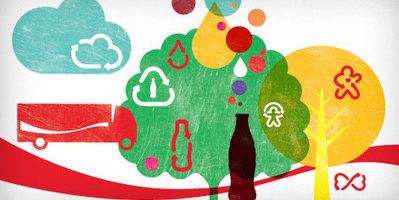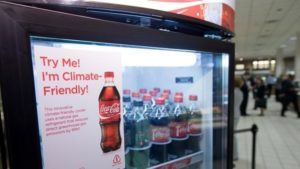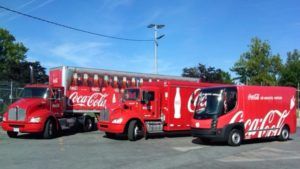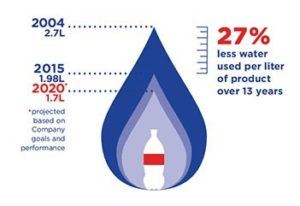The Iconic Red Coke Bottle Tries Green On for Size

The world’s ten largest food and beverage companies, Coca-Cola included, collectively produce carbon emissions that would rank them as the 25th largest emissions-producing country[1]. Is there a way for the “Big 10” to meaningfully reduce these harmful effects and increase the sustainability of our planet?
Looming Threats to the Beverage Industry
Within the last decade, the effects of climate change have garnered international attention, becoming prevalent in the political scene and (almost) unanimously recognized by the global community. In response, corporations have increasingly turned their focus to mitigating the threats posed on the environment in order to ensure continued business viability.
Fighting climate change is a tough pill to swallow for players in the beverage industry. As a company who relies heavily on the future prosperity of agriculture for sustained procurement of raw materials (i.e. sugar cane, sugar beets, and citrus), Coca-Cola finds itself particularly vulnerable to threatened supplies of key commodities[2]. Water conservation is also an important priority, since water is the primary ingredient in its products[2]. Furthermore, the company’s supply chain processes accelerate the harm to the planet; manufacturing, packaging, and transportation of its products all worsen the overall carbon footprint[2]. If regulations on emissions become more stringent, Coca-Cola will undoubtedly suffer.
First Steps in Coca-Cola’s Sustainability Initiatives
To combat the above risks and allow for the continued well-being of the planet, Coca-Cola has prioritized shrinking its climate change contributions while growing its businesses. For instance, the company has committed to reducing the carbon footprint of “the drink in your hand” by 25% by 2020 (benchmarked to the 2010 version); by 2015, it had achieved a 13% reduction in this metric[2]. Other key initiatives include:
Cooling Equipment: At Coca-Cola, refrigeration is the largest source of greenhouse gas emissions[2]. To mitigate this, the company is phasing out hydrofluorocarbon refrigerants, which “function as a sort of supercharged greenhouse gas, with 1,000 times the heat-trapping potency of carbon dioxide” (Davenport)[3]. The company is also placing intelligent energy management devices inside vending machines, which has resulted in a 40% increase in energy efficiency since 2000 from light and temperature adjustments inside the coolers[4].
Exhibit 1: Eco-Friendly Vending Machines
Distribution: Coca-Cola boasts a fleet of 650 heavy-duty hybrid delivery trucks which consume 30% less fuel than standard trucks[5]. Additionally, the company trains its drivers in “eco-friendly” driving techniques (i.e. minimal braking) and invests in technology aiming to reduce its emissions by minimizing idling and fuel usage[5].
Exhibit 2: Coca-Cola Hybrid Trucks
Water Conservation: As the 24th largest industrial consumer of water, Coca-Cola must closely monitor its water use. To date, the company has spent over two billion dollars on water conservation and water quality efforts[6]. As shown below, the company has reduced the amount of water used per liter of product by 27% over the last 13 years and hopes to achieve a further 14% reduction by 2020[7].
Exhibit 3: Water Conservation Progress
Packaging: Product advancement led to the creation of a Coca-Cola bottle that is “part plant” (composed 30% of sugar-cane-based materials), but that looks, feels and functions identically to the pure-plastic alternative. This innovation reduces the bottle’s carbon footprint by 12-19%[8].
But Is This Enough?
Although Coca-Cola has taken commendable steps to reduce its adverse impact on the environment, considerable room for improvement remains. Within the company, ideas include: (1) Prioritizing worldwide adoption of hydrofluorocarbon-free equipment; (2) Shifting its entire delivery fleet to hybrid vehicles; and (3) Continuing to innovate and revolutionize product packaging to decrease the harmful effects of reliance on plastic.
However, collective efforts are necessary to successfully tackle a challenge as large as climate change. As an industry leader and global mogul, the company can influence and exemplify climate change initiatives both internally (within its own supply chain) and externally (with other players).
Although some companies, like Coca-Cola, are committed to climate change initiatives, evidence indicates that oftentimes their suppliers do not share that commitment, trivializing the overall impact of sustainability in the production process[9]. For example, agricultural producers generally do not focus on cutting emissions, despite creating over half of the total emissions in the supply chain[1]. Coca-Cola has the clout to leverage scale and purchasing power in order to influence its supply chain to further these initiatives and hold parties accountable for measured outcomes.
Additionally, Coca-Cola has the opportunity to increase awareness and visibility of climate protection efforts to industry players. By encouraging others to join the Beverage Industry Environmental Roundtable, they can further BIER’s mission of “bringing together leaders in the beverage industry to advance the sector’s environmental stability”[10].
Exhibit 4: Current BIER Members
What more do you think that Coca-Cola could do to encourage others to get involved and interested in the imminent impacts of climate change? Some may argue that the company shouldn’t bear the responsibility of educating the entire industry, but at what cost does that come to the future for all?
(Word Count: 800)
Endnotes:
[1] “Big Ten Food Companies Emitting as Much as the ‘World’s 25th Most Polluting Country’.” US Official News, May 21, 2014, LexisNexis Academic. http://www.lexisnexis.com.ezp-prod1.hul.harvard.edu/lnacui2api/results/docview/docview.do?docLinkInd=true&risb=21_T24971156592&format=GNBFI&sort=RELEVANCE&startDocNo=1&resultsUrlKey=29_T24971156596&cisb=22_T24971156595&treeMax=true&treeWidth=0&csi=400469&docNo=14, accessed November 2016.
[2] The Coca-Cola Company. “2014/2015 Sustainability Report” (PDF file). Downloaded from Coca-Cola website. http://www.coca-colacompany.com/content/dam/journey/us/en/private/fileassets/pdf/2015/09/2014-2015-sustainability-report.pdf, accessed November 2016.
[3] Davenport, Coral. “Nations, Fighting Powerful Refrigerant That Warms Planet, Reach Landmark Deal.” New York Times, October 15, 2016. http://www.nytimes.com/2016/10/15/world/africa/kigali-deal-hfc-air-conditioners.html, accessed November 2016.
[4] The Coca-Cola Company. “Cooling Equipment: Pushing Forward with HFC-Free.” http://www.coca-colacompany.com/stories/cooling-equipment-pushing-forward-with-hfc-free, accessed November 2016.
[5] The Coca-Cola Company. “Sustainability Update: Energy Efficiency and Climate Protection.” http://www.coca-colacompany.com/our-company/sustainability-update-energy-efficiency-and-climate-protection, accessed November 2016.
[6] Fink, Carly, and Tensie Whelan. “The Comprehensive Business Case for Sustainability.” Harvard Business Review, October 21, 2016. https://hbr.org/2016/10/the-comprehensive-business-case-for-sustainability, accessed November 2016.
[7] The Coca-Cola Company. “Improving Our Water Efficiency.” http://www.coca-colacompany.com/setting-a-new-goal-for-water-efficiency, accessed November 2016.
[8] Herring, Chris. “Coke’s New Bottle is Part Plant.” The Wall Street Journal, January 24, 2010. http://www.wsj.com/articles/SB10001424052748703672104574654212774510476, accessed November 2016.
[9] Shankleman, Jessica. “Supply Chain Thwarts Coca-Cola, Goldman Sachs Action on Climate.” Bloomberg, January 26, 2016. http://www.bloomberg.com/news/articles/2016-01-26/supply-chain-thwarts-coca-cola-goldman-sachs-action-on-climate, accessed November 2016.
[10] Beverage Industry Environmental Roundtable. “About”. http://www.bieroundtable.com/about, accessed November 2016.
Photo / Exhibit Credit:
Cover photo: The Coca-Cola Company. “Sustainability.” http://www.coca-colacompany.com/topics/sustainability, accessed November 2016.
Exhibit 1: The Coca-Cola Company. “Cooling Equipment: Pushing Forward with HFC-Free.” http://www.coca-colacompany.com/stories/cooling-equipment-pushing-forward-with-hfc-free, accessed November 2016.
Exhibit 2: The Coca-Cola Company. “Coca-Cola Electrifies the Road with Hybrid Electric Fleet.” http://www.coca-colacompany.com/press-center/press-releases/coca-cola-electrifies-the-road-with-hybrid-electric-fleet, accessed November 2016.
Exhibit 3: The Coca-Cola Company. “2014/2015 Sustainability Report” (PDF file). Downloaded from Coca-Cola website. http://www.coca-colacompany.com/content/dam/journey/us/en/private/fileassets/pdf/2015/09/2014-2015-sustainability-report.pdf, accessed November 2016.
Exhibit 4: Beverage Industry Environmental Roundtable. “Members”. http://www.bieroundtable.com/members, accessed November 2016.







It sounds like Coke’s strategy is to “do more of the same.” That will likely help, but with decreasing marginal returns. At a minimum Coke should take a lesson from Starbucks and work to educate its suppliers and enforce standards that are congruent with Coke’s stated environmental priorities. Coke has the luxury of massive leverage – I hope they put it to good use!
I found this very interesting, in particular, the parallels it has to the Ikea case. Both are industry leaders that are focused on what they can do within their own organization and with their supply chain to reduce their harmful effects and their threatened raw materials. One lesson we learned from Ikea is it is very hard to force your supply chain to adhere to certain environmental standards. We saw Ikea focus on vertically integrated their supply chain and buy forests. My question for you would be has Coca-Cola considered making this investment in its supply chain? Unlike furniture that can be made from different materials other than wood, I think it is safe to say Coca-Cola will not be changing its recipe for its classic drinks so there would be less threat to investing in the supplies. In addition, I imagine the yields for sugar crops are much faster than the 50 years Ikea was facing.
One push-back on this could be that in Ikea’s case, despite Ikea being a market leader, it was a very fragmented industry. Coca-Cola operates in a much more consolidated industry so perhaps it has more bargaining power and control over its suppliers, particularly if others in the industry are focused on similar initiatives which I know Pepsi and General Mills are. http://www.environmentalleader.com/2016/10/25/food-beverage-companies-target-suppliers-water-efficiency/
Thanks for sharing this article. It sounds like Coca Cola is a little bit hesitant to leverage its size when dealing with its supply chain partners, which I find surprising. Several leaders of other industries, such as Proctor & Gamble and IKEA, have taken a proactive and in some cases a hard-line stance with respect to sustainable supply-chain partners. I would love to see Coca Cola, as one of the most well-known and respected brands in the world, take a similar stance.
Furthermore, I would love to see Coca Cola leverage its name brand to reach out and educate and influence consumers on the effects of climate change as well. Just posting sustainability articles and strategies on their website is too passive an approach for the urgency of the situation, in my opinion. I would love to see more proactive programs that aim to promote sustainability in the consumer. For example, influencing customers’ decision to purchase products that minimize harmful waste (efficient sizes, packaging, etc.). Overall, it sounds like Coca Cola is taking the right steps, but the question is whether or not they are taking them fast enough.
Very interesting read, thanks for posting kimber. I like your company selection because many people don’t synonymize consumer staples companies as having an impact on climate change when in fact they do! The initiatives that Coca-Cola has taken are a good start, but are they enough given the level of brand recognition that they have across the globe. With the leadership and impact that they carry should they take even more initiative to lead the food and beverage industry to be one of the industries that is at the for-front of combating climate change. Finally, as a company that sells a product that effectively “pollutes” the human body and has been proven as a contributor to diabetes doesn’t it seem a bit hypocritical that they are trying to save the environment but not people’s health? Maybe they’re just doing the minimum to keep regulators off their backs. http://articles.mercola.com/sites/articles/archive/2015/08/05/soda-diabetes-link.aspx
It is definitely clear that Coca-Cola realizes the severity that continued climate change at this rate will affect their business. And unlike some of the other companies I have read about through this assignment, Coca-Cola has implemented measurable initiatives that you have outlined above which is definitely a signal that they want to be part of the solution. I think that BIER has the potential to be the largest power of the industry when it comes to addressing the supply chain problems brought up above. Although Coca-Cola has large leverage alone, coming together as a group magnifies it so much more. If the suppliers know that they have no choice but to make a change, they will certainly not want to lose business from the array of big players shown as BIER members. If half of the total production emissions come from elsewhere in the supply chain, BIER should certainly set their sights towards others as well as internally!